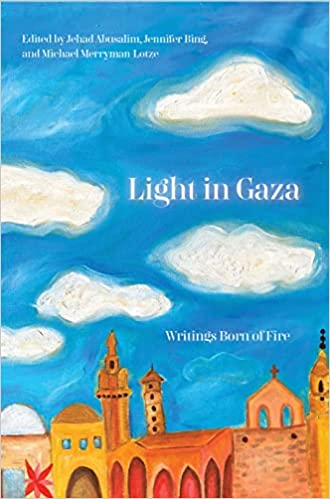“Light in Gaza – Writings Born of Fire”
A review of "Light in Gaza - Writings Born of Fire" by Jehad Abusalim, Jennifer Bing,, Michael Merryman Lotze. Haymarket Books, Chicago, IL, 2022

All Global Research articles can be read in 51 languages by activating the “Translate Website” drop down menu on the top banner of our home page (Desktop version).
To receive Global Research’s Daily Newsletter (selected articles), click here.
Visit and follow us on Instagram, Twitter and Facebook. Feel free to repost and share widely Global Research articles.
***
The actual history of Gaza can be readily researched – the dates, the actions, the numbers. What is not readily available is information beyond the Israeli narrative of Gaza being populated by terrorists. This current book, a collection of writings by Palestinians from Gaza – residents, domestic refugees, or immigrant refugees – places the narrative into a human and very humane context, the reality of a dispossessed people living under occupation, desiring the freedom to live as others do in western ‘democracies’. Light in Gaza – Writings Born of Fire reveals the dreams, fears, and aspirations of the Gaza residents and diaspora.
Thematically, the stories talk of life under occupation and violence, but only indirectly as the discussions talk of what under normal circumstances would be rather mundane ideas. Families and travel are two main themes as the occupation does its best to restrict travel domestically and abroad (mostly for educational and medical purposes), separating families and in that aspect attempting to eliminate a part of the Palestinian culural heritage. Life is described as a permanent temporality, not knowing when movement will be allowed or not, when the electricity will be on or not, when there will be water available (when the electricity is on), when one can communicate to one’s distant relatives (mostly when the electricity is on).
The latter comment is emphasized as it appears the title of the book comes from the chapter “People’s Light in Gaza’s Darkness” where the lack of electricity shapes much of the daily life of Palestinians – when to get water, when to do homework, when to study for exams, when to bake the bread…and in the dark of night, the sounds of drones, of jets, of soldiers and tanks running through the streets – leaving “Gazans enveloped in a debilitating state of fear, perpetual waiting, and deep-seated anxiety.”
Yet there is a resolve within their “state of being” after fifteen years of lockdown in the world’s largest prison. Palestinians continue to rebuild with materials at hand. They support many libraries and have an educational system producing an amazing literacy rate considering the circumstances of ongoing dislocation and disruption. In spite of the harsh conditions – the free fire zones near the border with Israel, the repeated destruction physically and chemically – Gaza attempts to grow its own food, serving both as the obvious necessity, but also supporting the cultural heritage of traditional Palestinian meals.
The Israelis use AI to control and monitor the situation in Gaza, using the latest technology and ‘field testing’ it for others (drones, facial recognition robots, advanced sensors), creating a surveillance state that in turn limits the use of current technology in Gaza.
In contrast, with what is available Palestinians use technology to their benefit. One of the areas identified is the availability of high resolution satellite imagery to identify agricultural land, Israeli settlements, water sources, and military movements. It can be used to identify the many villages destroyed or occupied by Israel “which reinforces the belief that the right of return is not impossible, providing images of Palestine to the “displaced who are unable to visit their homeland.” Other AI uses include creating a data bank to bring Israeli war crimes to justice, ‘colorizing’ old photos of historic Palestine, and providingassistance for physicians
After a chapter on travel restrictions which creates a geographical separation on families, work, education – on society as a whole – the book ends with what remains as a strength for the people of Gaza – “Let me Dream.”
The dreams fall under two interconnected ideas – the freedom to have family reunions and the freedom to travel. The latter has many other components, as simple as being able to see the mountains of the West Bank, to come and go freely to an outside university or for medical assistance, to see other countries and encounter new ideas…and after many generations, to travel and visit where the family home originally was located.
The stories have a strong emotive content, are honest in their expressions, and above all create a strong sense of the humanity and peaceful desires for the people of Gaza. Seventy years after the nakba and fifteen years after lockdown, Gaza is both a prison with millions facing destitution and a possible unlivable future, at the same time it carries on with its dreams and the light of hope, learning, family, and the freedom it deserves equally with other citizens of the world.
Light in Gaza is a strong honest presentation of today’s Gazans, a necessary read that provides a good understanding of the humanity of the Palestinians in Gaza. It is a very valuable addition to the library of books on Palestine and Gaza in particular.
*
Note to readers: Please click the share buttons above or below. Follow us on Instagram, Twitter and Facebook. Feel free to repost and share widely Global Research articles.
Jim Miles is a regular contributor to Global Research.
Featured image is from Amazon

